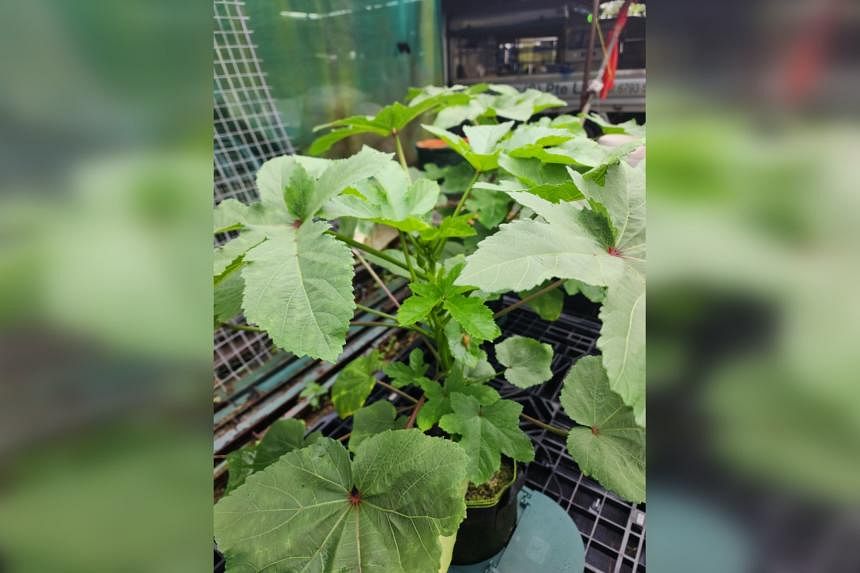Grow Lady’s Finger plants from seeds
What is the difference between the whole and subdivided leaves of the Lady’s Finger? Also, what is the correct way to propagate the dwarf version of this plant?
Adrian Ling
The leaves of the Lady’s Finger change shape as the plant matures. Young plants tend to have whole leaves, which gradually become more deeply lobed.
Gardeners collect seeds for growing crops of Lady’s Fingers, as seed-grown plants tend to be more vigorous. Grow an open-pollinated variety, as hybrids do not breed true – meaning that the resulting plants may not be the same as their parents.
Also, do not grow other Lady’s Finger varieties nearby, as they can cross-pollinate.
Crown of Thorns infested with sap-sucking insects
This succulent used to be very leafy but has been shedding yellow leaves. I also noticed some white cotton-like material on the stalks. Are these mealy bugs? Can I save the plant?
Sindy Ang
Your Crown of Thorns (botanical name: Euphorbia milii) is a sun-loving plant, so its leaves will turn yellow and fall when placed in too dim a location. Give it at least six hours of direct sunlight daily for optimal growth.
The white cotton-like material could be mealy bugs, which is a common type of sap-sucking pest. Remove them by washing them off with a strong jet of water.
Next, spray the plant with summer oil, an organic pesticide that is available for sale in local nurseries. It works by penetrating the waxy coating on the pests and suffocating them. When spraying, ensure thorough coverage of the plant and follow the instructions on the label. Also, spray during a cooler time of day to reduce the likelihood of injury – namely, pesticide burn – to leaves, which can happen during hot days with intense sunlight.
Golden Variegated Ctenanthe is a popular foliage plant
What is this plant? Is it an indoor plant?
Lim Tian San
This plant is the Golden Variegated Ctenanthe or Golden Mosaic (botanical name: Ctenanthe pilosa). Although it is marketed as an indoor plant, this species should not be grown in deep shade. Place it in a protected, humid location with filtered sunlight for about four hours daily. Do not place it in a windy spot, as wind can dry the plant out quickly.
Golden Barrel Cactus commonly sold in local nurseries
Where can I buy a Golden Barrel Cactus and how do I care for it?
Tan Wah Kheng
The Golden Barrel Cactus (botanical name: Echinocactus grusonii) is likely the most common species of cactus that can be found in Singapore. Most nurseries and online shopping platforms stock it.
As with most desert cacti, this species needs to be grown under direct sunlight for at least six hours daily in a gritty, well-draining soil mix. Also, grow it under a clear shelter that protects the plant from heavy rain, as wet feet can cause the plant to rot and die.
Ensure the plant gets good air circulation and monitor it for any infestations of scale insects, as they are common pests for this plant.
Fiddle Leaf Fig needs direct sunlight to thrive
Our Fiddle Leaf Fig gets indirect sunlight for about two to four hours a day, with indoor lights as well.
I previously watered it with about 250ml of water twice weekly. A few weeks back, it started to develop brown spots on its leaves and shed about half of its leaves. I then repotted the plant into a bigger container, topping up with cactus soil. Since then, I have been watering it with about 600ml of water once a week when the surface of the soil is dry to the touch, but the brown spots on its leaves are spreading. What can I do?
Amelia Ng
The Fiddle Leaf Fig (Ficus lyrata) needs at least six hours of direct sunlight daily. Healthy specimens can be seen in outdoor gardens. They tolerate shady conditions only for short periods before their health fails and they become susceptible to pests and disease.
As for the black patches and shedding leaves, these may be due to transplant shock. Did you disturb the roots by removing soil from the root ball? Such a procedure damages the roots and impairs the plant’s ability to take up water. Plants that suffer from transplant shock will shed leaves and younger leaves will also turn brown and die.
Depending on the extent of the injury, the plant may take some time to recover and produce new roots. During this period, ensure the plant is not exposed to strong sunlight, which can cause it to lose water rapidly.
Finally, when watering plants, water enough that a slight excess trickles out from the drainage holes found at the base of the pot. This is an indication that the root ball has been thoroughly moistened. Remove the excess water to ensure the plant does not suffer from wet feet.
Answers by Dr Wilson Wong, an NParks-certified practising horticulturist and parks manager. He is the founder of Green Culture Singapore and an adjunct assistant professor (Food Science & Technology) at the National University of Singapore.
Have a gardening query? E-mail it with clear, high-resolution pictures of at least 1MB, if any, and your full name to stlife@sph.com.sg. We reserve the right to edit and reject questions.
Root Awakening: Pencil Cactus flowers are easily missed
Root Awakening: Cucumber plant is diseased
Join ST’s Telegram channel and get the latest breaking news delivered to you.
p.st_telegram_boilerplate:before {
display: inline-block;
content: ” “;
border-radius: 6px;
height: 6px;
width: 6px;
background-color: #12239a;
margin-left: 0px;
margin-right: 13px;
}
a.st_boilerplate {
font-family: “SelaneWebSTForty”, Georgia, “Times New Roman”, Times, serif;
}


